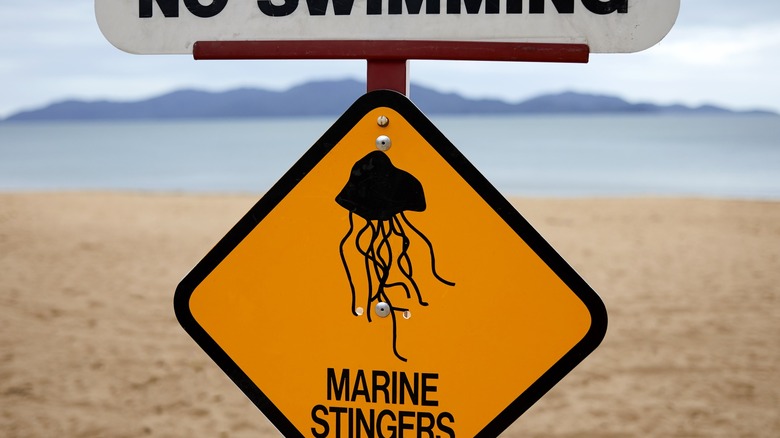Here's What You Need To Know About Deadly Box Jellyfish Before Your Next Beach Vacation
Thanks to "Jaws," we all know there are some dangerous, shark-infested waters out there, and it's probably no secret that we should pay attention to the deadly currents of Florida's most dangerous beaches. But there's another villain in the waters, too: the Australian box jellyfish. Its blueish, translucent body is covered in tentacles that can puncture their prey, causing potentially deadly conditions.
Jellyfish are known for their colorful, umbrella-shaped heads and stringy limbs. Although they're 95% water, that last 5% does pack a punch — they can use their tentacles to prick their prey with poisonous venom. The average jellyfish sting is a painful but temporary inconvenience. That stands in stark contrast to the box jellyfish, which carries toxic venom that can cause severe reactions like cramping and paralysis within five minutes, preventing the victim from even returning to shore. According to Britannica, between 40 and 100 fatalities from Australian box jellyfish are reported annually, though these are probably low estimates. Even when not deadly, their stings can leave lingering pain for weeks to come. Read on to learn where to find them, and what to do if you have the misfortune of being stung by one.
Their advanced adaptations make them stand out
The box jellyfish has remarkable clusters of eyes — 24 in total — and each one is complete with a lens, retina, iris, and cornea. We don't know exactly how their vision works, but it allows them to discern between light and dark and avoid objects that aren't moving — and thus hunt their prey. They do this through another unique adaptation: swimming. Unlike other varieties of jellyfish that simply float where the current takes them, box jellyfish can swim at speeds up to 4 knots, allowing them to follow prey in the water. If you see a jellyfish and change your direction only to be followed, you might have a box species on your tail.
Scientists studying the venom of box jellyfish have learned that it contains several proteins. Some of these molecules can puncture cells and even attack heart muscle. While there is no consensus on how one might prevent this toxicity, a 2019 study released in the scientific journal Nature Communications suggests that cholesterol is required for this venom to induce cell death, and cholesterol medications helped reduce their toxicity.
Thankfully, avoiding – or surviving – a box jellyfish sting is possible
Although they swim in warm-water currents around the world, the National Ocean Service says the lethal varieties of box jellyfish, like the Australian box jellyfish, mostly live in the Indo-Pacific and off the coast of northern Australia. The Australian government says reports of box jellyfish injuries are mostly recorded during the "stinger season" of October 1 to June 1, when they're likely to be found in the shallow waters of the Northern Territory. Watch out for boat ramps and river and creek outlets, where they often hang out when the seas are calm.
The good news? Even the most venomous sting can be treated immediately with vinegar (not fresh water) and antivenom at the hospital. And although the poison of the less-toxic box jellyfish, like those found in the Caribbean, can still be painful, they likely won't be lethal. For a stress-free vacation, visit one of the safest Caribbean islands, where the box jellyfish are less dangerous and hopefully remain out of coastal waters.


